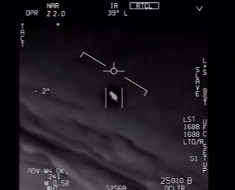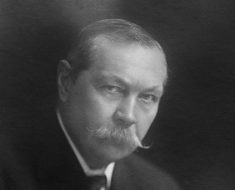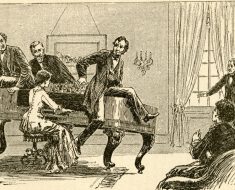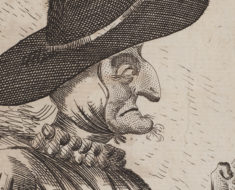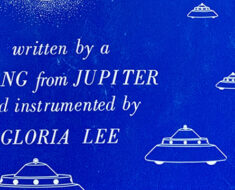In the 1860s, the dead were reappearing from the beyond through raps on tables, messages from mediums, and most extraordinarily, in photographs.
The first spirit photo was taken by accident in 1861 by William Mumler, a jeweler and photographer working in Boston. After taking a self-portrait, he noticed an image of someone behind him. At first he assumed he just hadn’t cleaned the plate properly, so he cleaned it again, took another photo, and still saw a ghost. He recognized the faint figure as a deceased cousin.
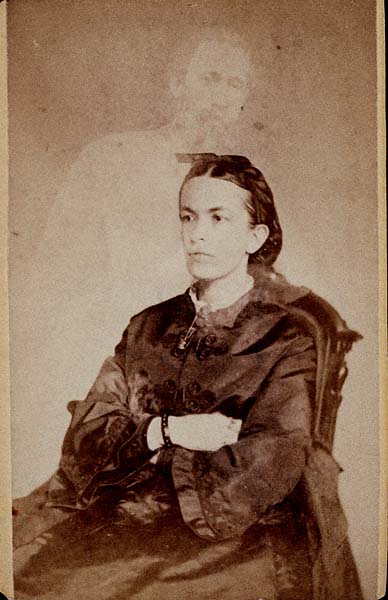
Mumler’s photograph of Fanny Conant and an unknown dead person behind her. Conant was a medium at the time. Image via Wikimedia Commons.
Enthusiastic Spiritualists, of which there were many in Boston, proclaimed that Mumler had opened a new door to the afterlife. Photography was still a relatively recent phenomenon, leading many to believe that the camera could quite possibly see things the human eye couldn’t. Mumler rolled with the wave of excitement and began taking more photos of people eager to fork over ten bucks. He never promised a spirit would appear, but they often did.
Naturally, there were skeptics. People assumed there was trickery involved and wished to investigate his photographic process. He allowed several such investigations. A Spiritualist newspaper, the Banner of Light, printed this letter on November 18, 1862, stating the observations of another photographer, William Guay:
Mr. Editor,—Having been informed by Mr. William H. Mumler that you desire to publish the results of my investigation into the possibility and genuineness of Mr. M.’s photographic impressions of spirit forms, it gives me much pleasure to detail to you what I have seen. As I have been commissioned by Messrs. J. Davis and Co., you can rest assured that I was resolved, if permitted, to allow nothing to slip my utmost scrutiny. Having had ten years’ continual practice in this particular branch—that is, negative on glass, and positive on paper from negative—I felt competent to detect any form of deception. Having been permitted by Mr. Mumler every facility to investigate, I went through the whole of the operation of selecting, cleaning, preparing, coating, silvering, and putting into the shield, the glass upon which Mr. M. proposed that a spirit form and mine should be imparted, never taking off my eyes, and not allowing Mr. M. to touch the glass until it had gone through the whole of the operation. The result was, that there came upon the glass a picture of myself, and, to my utter astonishment—having previously examined and scrutinised every crack and comer, plate-holder, camera, box, tube, the inside of the bath, &c.—another portrait. Having since continued, on several occasions, my investigations, as described above, and received even more perfect results than on the first trial, I have been obliged to endorse its legitimacy. Respectfully yours, Wm. Guay.”
The Banner of Light was quite pleased with Guay’s report. Mumler surely was, too, as the dead were helping him make a good living. The great loss of life during the Civil War translated to more business from grieving family members wishing to make contact with deceased loved ones. Over the years, he took thousands of photographs, including one of Mary Todd Lincoln showing the assassinated president behind her. P.T. Barnum, always one to enjoy a good humbug, was intrigued as well and displayed several Mumler photographs in his American Museum.
But with growing success came more skeptics. And eventually, some of them noticed that several spirits were actually people still living.
By 1869, the police were on the case and claimed Mumler was swindling people out of their money. The spirit photographer went to court, supported by the Spiritualist community who maintained their belief that he was innocent and genuine.
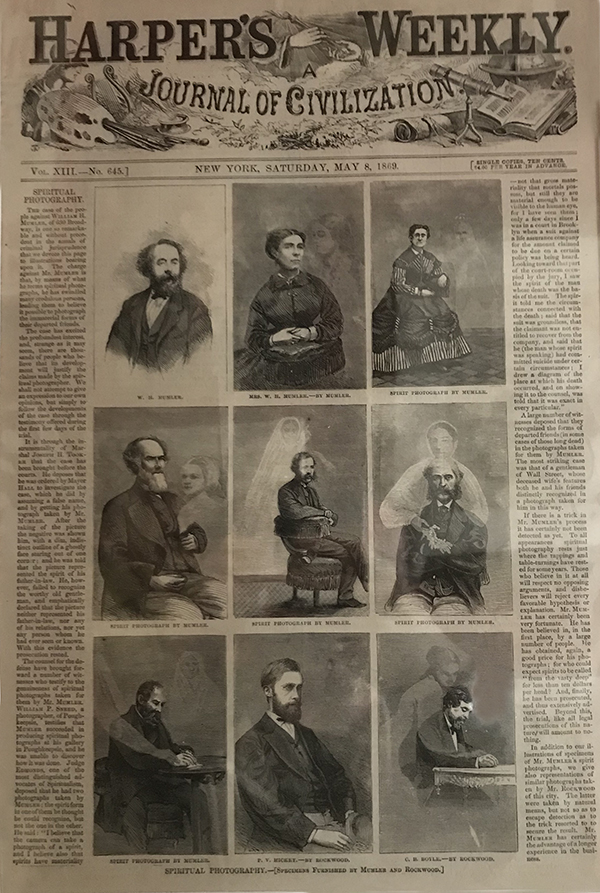
Harper’s Weekly reported on the Mumler case in its May 8, 1869 edition. Hartzman Collection.
P.T. Barnum, however, wasn’t buying it. In fact, he had planned to include Mumler in a book about humbugs.
“I went yesterday to Mr. Bogardus’s gallery, and asked him if he could take a spirit photograph, telling him that I did not want any humbug about it,” Barnum testified. “He said he could do it. I examined the glass, and discovered nothing in it. I saw the process of pouring over the first liquid, and afterwards the pouring over of nitrate of silver, and then saw it placed in the camera. When done it had my likeness and the shadow of Abraham Lincoln. I saw the ghost of Lincoln as soon as it was developed in the dark room. I was unconscious of any spiritual presence.”
Others testified in Mumler’s defense, swearing the images were real. “I have had a photograph of my deceased daughter, who died in August, 1863,” a believer, Paul Bremond, told the court. “She told me when she died that if it were permitted she would return to me from the spirit land. By this photograph I see that she has returned.”
Another photographer, William Slee of Poughkeepsie, New York, testified that Mumler produced spirit photographs in his own gallery and had no idea how he’d done it.
Ultimately, no proof was given that Mumler had been deceptive in his techniques and he was acquitted. Despite the win, Mumler’s business suffered afterward and he faded into obscurity. Spiritualism, however, kept going strong well into the twentieth century. Mediums capitalized on a willingness to believe however they could, through séances, spirit writings, and yes, many more spirit photographs.
For more on William Mumler, read The Strange Case of William Mumler, by Louis Kaplan, and The Apparitionists: A Tale of Phantoms, Fraud, Photography, and the Man Who Captured Lincoln’s Ghost, by Peter Manseau. And read about how 19th-century photographers created ghosts in 3D, right here on Weird Historian or visit HartzmanStereoviews.com.

![Ted Serios, by Jule Eisenbud [Public domain], via Wikimedia Commons](https://www.weirdhistorian.com/wp-content/uploads/2017/05/Ted_Serios_1-crop-235x190.jpg)
